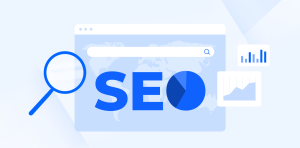How Web Design Affects SEO Promotion of the Site

Often, after a website audit, clients see recommendations for design fixes in the final report. It would seem that this has nothing to do with SEO? Ironically, many website owners still associate search engine promotion with the keywords in the texts of pages and links. And they are genuinely surprised when they see recommendations to change the navigation menu, the layout of elements on pages, restructure the directory, reduce the weight of images, etc.
Search algorithms are more multifaceted now than they were ten or even five years ago. In this article, we’ll examine how website design affects ranking in Google, and how, in this regard, you need to take SEO requirements into account when developing your design.
How design affects a website’s position in search engine rankings
When we talk about design, we are referring not so much to the attractiveness and beauty of the external design of the site (although this, too), as to the key components of a web resource: the quality of the layout, the organization of the scripts, the presence of the necessary elements, their location, and ease of interaction with them, the structure of components (menu, directory, pages). Simply put, all that in combination is the site for the user.
Advertising on the site
Search engines now also analyze the site holistically, from the perspective of the user. Therefore, the design of the resource has a direct impact on its position in the search engine. Here it is important to understand that most design components work on SEO simultaneously in two ways:
They represent a ranking factor. The search algorithm checks whether your site meets certain design requirements. If they are, it adds another point to your score.
Influence behavioral factors. For example, if the design is uncomfortable, unattractive, people will stay on the site only a little bit, and this will be a bad behavioral signal. Search engines track user behavior and, accordingly, increase or decrease the conventional evaluation of your site.
The main thing is that design affects your sales, and this is the third, most important influencing factor. Any commercial website is first and foremost a sales tool, and the design should provide exactly the conversions.
Next, consider the point-by-point relationship of design components with SEO, and understand what you need to analyze to identify problems.
Mobile version or adaptive design
The site should be designed so that users who visit it with smartphones or tablets can easily navigate through pages, view content, interact with buttons, links, etc. To accomplish this, either a separate mobile version of the site is created (pages are opened under a different URL), or the design is made adaptive, that is, adapting to different screen resolutions and device types. Both options are possible to create at a Washington DC design firm.
Why is this important? There is a “triple impact” at work here as well:
- Google checks whether the site is optimized for mobile devices. If the answer is yes, the site’s positioning improves;
- Behavioral factors on sessions from mobile devices improve, and the share of mobile traffic in some niches can be as high as 80%;
- If it is convenient for a visitor from mobile to choose and buy a product, then the conversion of the site increases.
Commercial factors
One of the most important points in SEO promotion of online stores. Commercial factors – a list of elements that need to be implemented on your site. They affect ranking directly, as well as behavioral factors and conversion rates, providing three important things:
- Building trust in you as a seller;
- Convenient and quick product selection on the site;
- Complete product information needed to make a buying decision.
Conclusion
It would be strange to try to list all the possible correlations between design and SEO in one short piece. Search engines have 1000+ ranking factors, and the promotion of each particular website depends on many details and individual company characteristics. It is important to remember that website development should be comprehensive, and it is best to involve SEO specialists in the very first stage. Their task is to audit competitors and make recommendations related to commercial blocks, design, and individual elements.






